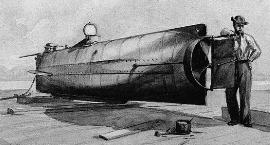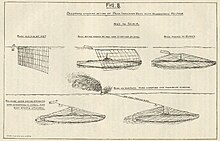
A naval mine is a self-contained explosive device placed in water to damage or destroy surface ships or submarines. Unlike depth charges, mines are deposited and left to wait until they are triggered by the approach of, or contact with, any vessel or a particular vessel type, akin to anti-infantry or anti-vehicle mines. Naval mines can be used offensively, to hamper enemy shipping movements or lock vessels into a harbour; or defensively, to protect friendly vessels and create "safe" zones. Mines allow the minelaying force commander to concentrate warships or defensive assets in mine-free areas giving the adversary three choices: undertake an expensive and time-consuming minesweeping effort, accept the casualties of challenging the minefield, or use the unmined waters where the greatest concentration of enemy firepower will be encountered.

Scapa Flow is a body of water in the Orkney Islands, Scotland, sheltered by the islands of Mainland, Graemsay, Burray, South Ronaldsay and Hoy. Its sheltered waters have played an important role in travel, trade and conflict throughout the centuries. Vikings anchored their longships in Scapa Flow more than a thousand years ago. It was the United Kingdom's chief naval base during the First and Second World wars, but the facility was closed in 1956.

Submarine warfare is one of the four divisions of underwater warfare, the others being anti-submarine warfare, mine warfare and mine countermeasures.

The first HMS Zulu was a Tribal class destroyer launched 16 September 1909 at Hawthorn Leslie Shipyard and commissioned in March 1910. She was mined during the First World War, on 27 October 1916 off Dover in a minefield lain by the Imperial German submarine UC-1. Her stern was blown off and sank, but the forward section remained afloat. It was towed into port and attached to the stern of Nubian, which had been torpedoed, to form a new destroyer named HMS Zubian.

An anti-submarine weapon (ASW) is any one of a number of devices that are intended to act against a submarine and its crew, to destroy (sink) the vessel or reduce its capability as a weapon of war. In its simplest sense, an anti-submarine weapon is usually a projectile, missile or bomb that is optimized to destroy submarines.

Constructed using light steel nets, indicator nets were often anchored at various depths to the sea bed around Allied naval bases during both world wars. They were intended to entangle U-boat traffic of the enemy, even though the submarines often managed to disentangle themselves and escape before being blown up by depth charges.

Torpedo nets were a passive ship defensive device against torpedoes. They were in common use from the 1890s until the Second World War. They were superseded by the anti-torpedo bulge and torpedo belts.

Anti-submarine warfare is a branch of underwater warfare that uses surface warships, aircraft, submarines, or other platforms, to find, track, and deter, damage, or destroy enemy submarines. Such operations are typically carried out to protect friendly shipping and coastal facilities from submarine attacks and to overcome blockades.

HMS Ghurka was a Tribal-class destroyer built in 1907 for the Royal Navy. She served as part of the Dover Patrol during the First World War, playing a part in the sinking of the German submarine U-8 in 1915, and was sunk by a German mine in 1917.

The Hamilton-class cutter was the largest class of vessel in the United States Coast Guard until replaced by the Legend-class cutter, aside from the Polar-class icebreaker. The hull classification symbol is prefixed WHEC. The cutters are called the Hamilton class after their lead ship, or the "Secretary class" because most of the vessels in the class were named for former Secretaries of the Treasury, with the exception of the "Hero-class cutters" Jarvis, Munro and Midgett.

HMS Viking was a Tribal-class destroyer of the Royal Navy launched in 1909 and sold for scrap in 1919. She was the only destroyer ever to have six funnels.

A net laying ship, also known as a net layer, net tender, gate ship or boom defence vessel was a type of naval auxiliary ship.

The Sydney Harbour anti-submarine boom net was an anti-torpedo and submarine defence net that was in Sydney Harbour during World War II. It spanned the entire width of the harbour from Laing Point, Watsons Bay to Georges Head Battery, on the northern side of Sydney Harbour. The boom formed part of the Sydney Harbour defences which also included artillery batteries and patrol boats.

Naval trawlers are vessels built along the lines of a fishing trawler but fitted out for naval purposes; they were widely used during the First and Second World Wars. Some—known in the Royal Navy as "Admiralty trawlers"— were purpose-built to naval specifications, others adapted from civilian use. Fishing trawlers were particularly suited for many naval requirements because they were robust vessels designed to work heavy trawls in all types of weather, and had large clear working decks. A minesweeper could be created by replacing the trawl with a mine sweep. Adding depth charge racks on the deck, ASDIC sonar below, and a 3-inch (76 mm) or 4-inch (102 mm) gun in the bow equipped the trawler for anti-submarine duties.
SM UB-26 was a German Type UB II submarine or U-boat in the German Imperial Navy during World War I. The U-boat was ordered on 30 April 1915 and launched on 14 December 1915. She was commissioned into the German Imperial Navy on 27 December 1915 as SM UB-26. UB-26 was trapped in anti-submarine nets trailed by the Trombe and was scuttled in Le Havre harbour on 5 April 1916. She was raised by the French on 30 August 1917 and served as Roland Morillot.
SM UC-44 was a German Type UC II minelaying submarine or U-boat in the German Imperial Navy during World War I. The U-boat was ordered on 20 November 1915 and was launched on 10 October 1916. She was commissioned into the German Imperial Navy on 4 November 1916 as SM UC-44. In 6 patrols UC-44 was credited with sinking 28 ships, either by torpedo or by mines laid. UC-44 was sunk by the detonation of one of her own mines off the Irish coast at position 52°07′N6°59′W on 4 August 1917; its commander, Kurt Teppenjohanns, was the only survivor. UC-44's wreck was raised by the Royal Navy in September 1917 and later broken up.

SM U-21 was a U-boat built for the Imperial German Navy shortly before World War I. The third of four Type U-19-class submarines, these were the first U-boats in German service to be equipped with diesel engines. U-21 was built between 1911 and October 1913 at the Kaiserliche Werft in Danzig. She was armed with four torpedo tubes and a single deck gun; a second gun was added during her career.
'The Admiralty M-N Scheme' was a World War I British plan to close the Strait of Dover in the English Channel to German U-boats, by means of a chain of either eight or twelve massive towers linked by anti-submarine booms and nets. Only two towers had been constructed before the Armistice with Germany caused the cancellation of the project.

A boom or a chain is an obstacle strung across a navigable stretch of water to control or block navigation.

The Dover Barrage was an underwater blockade by England of German submarines attempting to use the English Channel during World War I. The barrage consisted of explosive mines and indicator nets. A similar barrage was used in World War II.


















